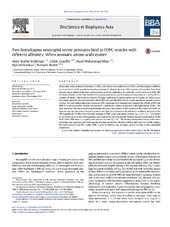| dc.contributor.author | Schillinger, Anne-Sophie | eng |
| dc.contributor.author | Grauffel, Cédric | eng |
| dc.contributor.author | Khan, Hanif Muhammad | eng |
| dc.contributor.author | Halskau, Øyvind | eng |
| dc.contributor.author | Reuter, Nathalie | eng |
| dc.date.accessioned | 2015-03-11T15:50:55Z | |
| dc.date.available | 2015-03-11T15:50:55Z | |
| dc.date.issued | 2014-12 | eng |
| dc.identifier.issn | 0005-2736 | en_US |
| dc.identifier.uri | https://hdl.handle.net/1956/9516 | |
| dc.description.abstract | Neutrophil serine proteases Proteinase 3 (PR3) and human neutrophil elastase (HNE) are homologous antibiotic serine proteases of the polymorphonuclear neutrophils. Despite sharing a 56% sequence identity they have been shown to have different functions and localizations in the neutrophils. In particular, and in contrast to HNE, PR3 has been detected at the outer leaflet of the plasma membrane and its membrane expression is a risk factor in a number of chronic inflammatory diseases. Although a plethora of studies performed in various cell-based assays have been reported, the mechanism by which PR3, and possibly HNE bind to simple membrane models remains unclear.We used surface plasmon resonance (SPR) experiments to measure and compare the affinity of PR3 and HNE for large unilamellar vesicles composed of 1-palmitoyl-2-oleoyl-sn-glycero-3-phosphocholine (POPC). We also conducted 500-nanosecond long molecular dynamics simulations of each enzyme at the surface of a POPC bilayer to map the interactions between proteins and lipids and rationalize the difference in affinity observed in the SPR experiment.We find that PR3 binds strongly to POPC large unilamellar vesicles (Kd=9.2 × 10−7 M) thanks to the insertion of three phenylalanines, one tryptophan and one leucine beyond the phosphate groups of the POPC lipids. HNE binds in a significantly weaker manner (Kd > 10−5M) making mostly electrostatic interactions via lysines and arginines and inserting only one leucine between the hydrophobic lipid tails. Our results support the early reports that PR3, unlike HNE, is able to directly and strongly anchor directly to the neutrophil membrane. | en_US |
| dc.language.iso | eng | eng |
| dc.publisher | Elsevier | en_US |
| dc.rights | Attribution-NonCommercial-NoDerivs CC BY-NC-ND | eng |
| dc.rights.uri | http://creativecommons.org/licenses/by-nc-nd/3.0/ | eng |
| dc.subject | Amphitropic protein | eng |
| dc.subject | Large unilamellar vesicles | eng |
| dc.subject | Molecular dynamics simulations | eng |
| dc.subject | SPR: surface plasmon resonance | eng |
| dc.subject | Proteinase 3 | eng |
| dc.subject | Neutrophil elastase | eng |
| dc.title | Two homologous neutrophil serine proteases bind to POPC vesicles with different affinities: When aromatic amino acids matter | en_US |
| dc.type | Peer reviewed | |
| dc.type | Journal article | |
| dc.date.updated | 2015-03-04T08:06:39Z | en_US |
| dc.description.version | publishedVersion | en_US |
| dc.rights.holder | Copyright 2014 The Authors | en_US |
| dc.identifier.doi | https://doi.org/10.1016/j.bbamem.2014.09.003 | |
| dc.identifier.cristin | 1211502 | |
| dc.source.journal | Biochimica et Biophysica Acta - Biomembranes | |
| dc.source.40 | 1838 | |
| dc.source.14 | 12 | |
| dc.source.pagenumber | 3191-3202 | |
| dc.relation.project | Norges forskningsråd 214167 | |
| dc.relation.project | Norges forskningsråd: 214167 | |
| dc.relation.project | Notur: nn4700k | |
| dc.relation.project | Bergens forskningsstiftelse: 2009 | |
| dc.subject.nsi | VDP::Mathematics and natural scienses: 400::Basic biosciences: 470::Bioinformatics: 475 | en_US |
| dc.subject.nsi | VDP::Mathematics and natural scienses: 400::Basic biosciences: 470::Molecular biology: 473 | en_US |
| dc.subject.nsi | VDP::Matematikk og naturvitenskap: 400::Basale biofag: 470::Bioinformatikk: 475 | nob |
| dc.subject.nsi | VDP::Matematikk og naturvitenskap: 400::Basale biofag: 470::Molekylærbiologi: 473 | nob |

